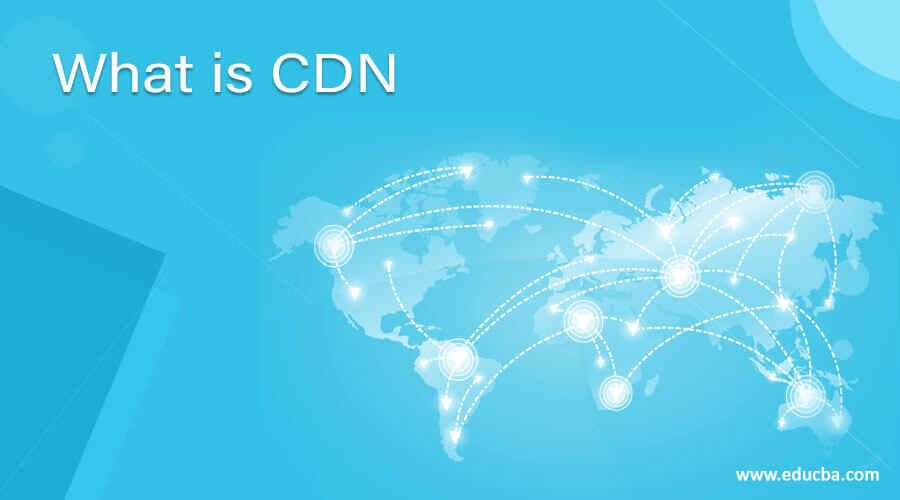Updated June 9, 2023
Introduction to CDN
(CDN) means a location community of servers working together to deliver internet content quickly. The CDN can easily transmit the assets required by HTML pages, javascript files, style sheets, images, and videos to be loaded on the Site. CDN service popularity continues to grow, with CDNs, including traffic from major sites such as Facebook, Netflix, and Amazon, serving today the bulk of the web traffic. The content origin server must answer any end-user request without a CDN.
This leads to the substantial origin and subsequent load flow, thus improving the chances of a loss of origin when traffic spikes are very high or when the load persists. In response to end-user requests and close proximity to the end-user, It downloads traffic from content servers. It enhances the web experience so that the content provider and end users benefit.
How does CDN Works?
A CDN stores a cached version of its content in several locations to reduce the distance between visitors and your website’s servers. Each PoP includes multiple cache servers responsible for distributing content to visitors nearby. Essentially, It puts the content on par with your customers in certain places.
E.g., if anyone accesses your website in London, the UK PoP is done locally. The questions of the user and the replies will move through the entire Atlantic and back. Their results will be much quicker. That’s how the functions briefly. Naturally, because we had thought we needed a whole guide to illustrate how the content distribution networks work in detail, the rabbit hole goes deeper.
Who Uses it?
Everybody, pretty much. They are now serving more than half of all traffic today. With each passing year, these figures are fast upward. There are a few reasons not to use the CDN when so many of you offer your services for free when any part of your business is online. But CDNs are not for everyone, even as a free service. In particular, with the vast majority of your users residing in the same region as your hosting, if you run a strictly localized platform, it is of little benefit. In this case, a CDN may potentially exacerbate the output of your website by adding another indispensable connecting point between the visitor and a nearby server.
Types of CDN
Our main purpose was to reduce latency and accelerate rendering. But this latency doesn’t matter in the modern world of 2MB pictures and 500kb of JavaScript libraries, which take 3 minutes to boot from websites. But also CDNs have other aims, which have evolved over time.
1. Security-oriented
The last layer of practicality added to CDNs was DDoS and bot protection. This is the specialty of CDNs such as Incapsula. The CDN is a website infrastructure’s outermost layer and its primary recipient. It allows DDoS attacks to be detected early and blocked by DDo Specific DDoS Protection Servers called scrubbers without ever reaching and crashing the server. In addition, It can learn about suspicious IPs, spammers, botters, and even types of crawlers and their behavior by using knowledge crowdsourced from many of its clients; for example, once identified, a scraper that operates on-site A stops working on-site B if that site is protected with the same CDN, as the traffic filter identifies a pattern it has previously seen.
2. Content-oriented
CDNs were originally only for static content (JS, CSS, HTML). When you created/uploaded it, you had to push content to it. Then the origin pulling was added to make things more automatic – a user requested the CDN URL, and then the CDN automatically requested the website’s URL to cache what it had ever received back. Availability has also become a major factor. Many CDNs now cache the “last live” state of a website to allow users to access the CDNed content if the origin falls, creating the stability illusion until the stuff returns to normal.
How does it Increase Load Times for a CDN?
Nearly all on the Internet have encountered the advantages of a content delivery network. Most tech companies, including organizations like Google, Apple, and Microsoft, use CDNs to minimize latency when loading content from web pages.
The main advantage is its capacity to produce material speedily. Optimizations for efficiency can be broken into three groups.
- Distance reduction: Decrease the distance between a customer and the data requested.
- Optimization of hardware or software optimization: server-side infrastructure performance, like using solid-state hard drives and effective load balancing.
- Lower data transmission: File size reduction techniques to rapidly load initial page loads.
Recommended Articles
This is a guide to What is CDN. Here we discuss the introduction, working, who uses it, and how it increase load times for a CDN. You may also have a look at the following articles to learn more –

